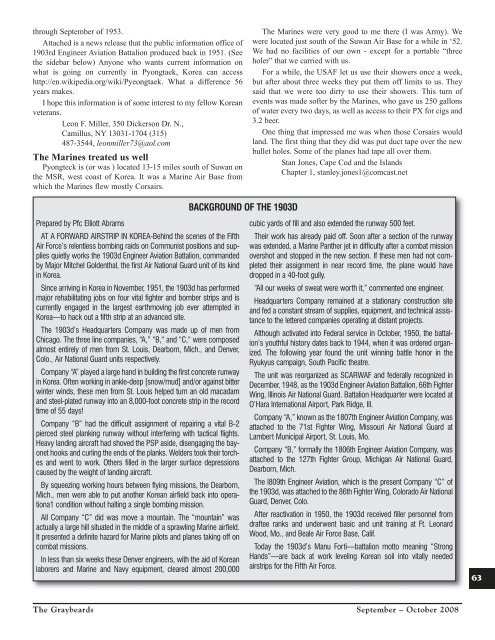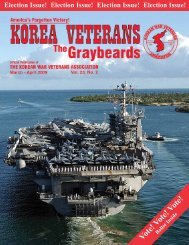Sep/Oct 2008 - Korean War Veterans Association
Sep/Oct 2008 - Korean War Veterans Association
Sep/Oct 2008 - Korean War Veterans Association
You also want an ePaper? Increase the reach of your titles
YUMPU automatically turns print PDFs into web optimized ePapers that Google loves.
through <strong>Sep</strong>tember of 1953.<br />
Attached is a news release that the public information office of<br />
1903rd Engineer Aviation Battalion produced back in 1951. (See<br />
the sidebar below) Anyone who wants current information on<br />
what is going on currently in Pyongtaek, Korea can access<br />
http://en.wikipedia.org/wiki/Pyeongtaek. What a difference 56<br />
years makes.<br />
I hope this information is of some interest to my fellow <strong>Korean</strong><br />
veterans.<br />
Leon F. Miller, 350 Dickerson Dr. N.,<br />
Camillus, NY 13031-1704 (315)<br />
487-3544, leonmiller73@aol.com<br />
The Marines treated us well<br />
Pyongteck is (or was ) located 13-15 miles south of Suwan on<br />
the MSR, west coast of Korea. It was a Marine Air Base from<br />
which the Marines flew mostly Corsairs.<br />
The Marines were very good to me there (I was Army). We<br />
were located just south of the Suwan Air Base for a while in ‘52.<br />
We had no facilities of our own - except for a portable “three<br />
holer” that we carried with us.<br />
For a while, the USAF let us use their showers once a week,<br />
but after about three weeks they put them off limits to us. They<br />
said that we were too dirty to use their showers. This turn of<br />
events was made softer by the Marines, who gave us 250 gallons<br />
of water every two days, as well as access to their PX for cigs and<br />
3.2 beer.<br />
One thing that impressed me was when those Corsairs would<br />
land. The first thing that they did was put duct tape over the new<br />
bullet holes. Some of the planes had tape all over them.<br />
Stan Jones, Cape Cod and the Islands<br />
Chapter 1, stanley.jones1@comcast.net<br />
BACKGROUND OF THE 1903D<br />
Prepared by Pfc Elliott Abrams<br />
AT A FORWARD AIRSTRIP IN KOREA-Behind the scenes of the Fifth<br />
Air Force’s relentless bombing raids on Communist positions and supplies<br />
quietly works the 1903d Engineer Aviation Battalion, commanded<br />
by Major Mitchel Goldenthal, the first Air National Guard unit of its kind<br />
in Korea.<br />
Since arriving in Korea in November, 1951, the 1903d has performed<br />
major rehabilitating jobs on four vital fighter and bomber strips and is<br />
currently engaged in the largest earthmoving job ever attempted in<br />
Korea—to hack out a fifth strip at an advanced site.<br />
The 1903d’s Headquarters Company was made up of men from<br />
Chicago. The three line companies, “A,” “B,“ and “C,“ were composed<br />
almost entirely of men from St. Louis, Dearborn, Mich., and Denver,<br />
Colo., Air National Guard units respectively.<br />
Company “A” played a large hand in building the first concrete runway<br />
in Korea. Often working in ankle-deep [snow/mud] and/or against bitter<br />
winter winds, these men from St. Louis helped turn an old macadam<br />
and steel-plated runway into an 8,000-foot concrete strip in the record<br />
time of 55 days!<br />
Company “B” had the difficult assignment of repairing a vital B-2<br />
pierced steel planking runway without interfering with tactical flights.<br />
Heavy landing aircraft had shoved the PSP aside, disengaging the bayonet<br />
hooks and curling the ends of the planks. Welders took their torches<br />
and went to work. Others filled in the larger surface depressions<br />
caused by the weight of landing aircraft.<br />
By squeezing working hours between flying missions, the Dearborn,<br />
Mich., men were able to put another <strong>Korean</strong> airfield back into operationa1<br />
condition without halting a single bombing mission.<br />
All Company “C” did was move a mountain. The “mountain” was<br />
actually a large hill situated in the middle of a sprawling Marine airfield.<br />
It pre sented a definite hazard for Marine pilots and planes taking off on<br />
combat missions.<br />
In less than six weeks these Denver engineers, with the aid of <strong>Korean</strong><br />
laborers and Marine and Navy equipment, cleared almost 200,000<br />
cubic yards of fill and also extended the runway 500 feet.<br />
Their work has already paid off. Soon after a section of the runway<br />
was extended, a Marine Panther jet in difficulty after a combat mission<br />
overshot and stopped in the new section. If these men had not completed<br />
their assignment in near record time, the plane would have<br />
dropped in a 40-foot gully.<br />
“All our weeks of sweat were worth it,” commented one engineer.<br />
Headquarters Company remained at a stationary construction site<br />
and fed a constant stream of supplies, equipment, and technical assistance<br />
to the lettered companies operating at distant projects.<br />
Although activated into Federal service in <strong>Oct</strong>ober, 1950, the battalion’s<br />
youthful history dates back to 1944, when it was ordered organized.<br />
The follow ing year found the unit winning battle honor in the<br />
Ryukyus campaign, South Pacific theatre.<br />
The unit was reorganized as SCARWAF and federally recognized in<br />
December, 1948, as the 1903d Engineer Aviation Battalion, 66th Fighter<br />
Wing, Illinois Air National Guard. Battalion Headquarter were located at<br />
O’Hara Inter national Airport, Park Ridge, Ill.<br />
Company “A,” known as the 1807th Engineer Aviation Company, was<br />
attached to the 71st Fighter Wing, Missouri Air National Guard at<br />
Lambert Municipal Airport, St. Louis, Mo.<br />
Company “B,” formally the 1806th Engineer Aviation Company, was<br />
attached to the 127th Fighter Group, Michigan Air National Guard,<br />
Dearborn, Mich.<br />
The l809th Engineer Aviation, which is the present Company “C” of<br />
the 1903d, was attached to the 86th Fighter Wing, Colorado Air National<br />
Guard, Denver, Colo.<br />
After reactivation in 1950, the 1903d received filler personnel from<br />
draftee ranks and underwent basic and unit training at Ft. Leonard<br />
Wood, Mo., and Beale Air Force Base, Calif.<br />
Today the 1903d’s Manu Forti—battalion motto meaning “Strong<br />
Hands”—are back at work leveling <strong>Korean</strong> soil into vitally needed<br />
airstrips for the Fifth Air Force.<br />
63<br />
The Graybeards<br />
<strong>Sep</strong>tember – <strong>Oct</strong>ober <strong>2008</strong>

















